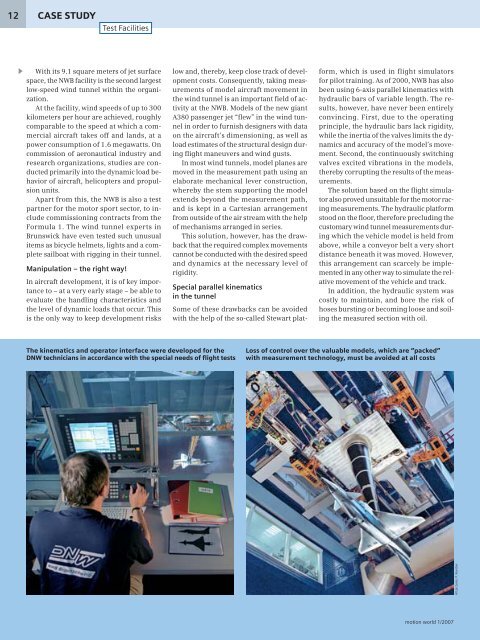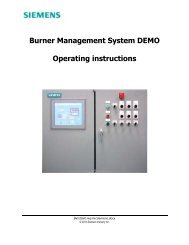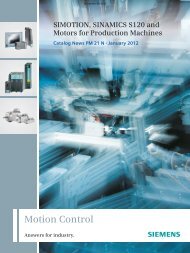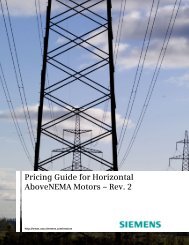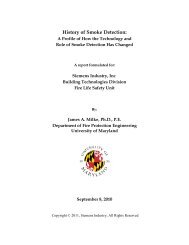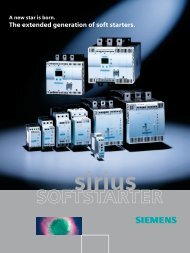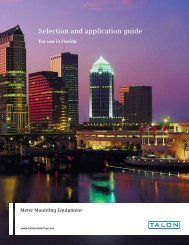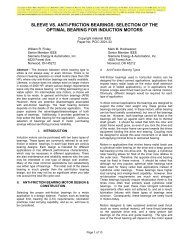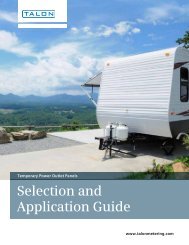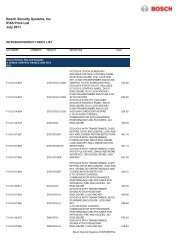Olympic Runners with Sinumerik and ShopMill Olympic Runners ...
Olympic Runners with Sinumerik and ShopMill Olympic Runners ...
Olympic Runners with Sinumerik and ShopMill Olympic Runners ...
You also want an ePaper? Increase the reach of your titles
YUMPU automatically turns print PDFs into web optimized ePapers that Google loves.
12<br />
CASE STUDY<br />
Test Facilities<br />
<br />
With its 9.1 square meters of jet surface<br />
space, the NWB facility is the second largest<br />
low-speed wind tunnel <strong>with</strong>in the organization.<br />
At the facility, wind speeds of up to 300<br />
kilometers per hour are achieved, roughly<br />
comparable to the speed at which a commercial<br />
aircraft takes off <strong>and</strong> l<strong>and</strong>s, at a<br />
power consumption of 1.6 megawatts. On<br />
commission of aeronautical industry <strong>and</strong><br />
research organizations, studies are conducted<br />
primarily into the dynamic load behavior<br />
of aircraft, helicopters <strong>and</strong> propulsion<br />
units.<br />
Apart from this, the NWB is also a test<br />
partner for the motor sport sector, to include<br />
commissioning contracts from the<br />
Formula 1. The wind tunnel experts in<br />
Brunswick have even tested such unusual<br />
items as bicycle helmets, lights <strong>and</strong> a complete<br />
sailboat <strong>with</strong> rigging in their tunnel.<br />
Manipulation – the right way!<br />
In aircraft development, it is of key importance<br />
to – at a very early stage – be able to<br />
evaluate the h<strong>and</strong>ling characteristics <strong>and</strong><br />
the level of dynamic loads that occur. This<br />
is the only way to keep development risks<br />
low <strong>and</strong>, thereby, keep close track of development<br />
costs. Consequently, taking measurements<br />
of model aircraft movement in<br />
the wind tunnel is an important field of activity<br />
at the NWB. Models of the new giant<br />
A380 passenger jet “flew” in the wind tunnel<br />
in order to furnish designers <strong>with</strong> data<br />
on the aircraft’s dimensioning, as well as<br />
load estimates of the structural design during<br />
flight maneuvers <strong>and</strong> wind gusts.<br />
In most wind tunnels, model planes are<br />
moved in the measurement path using an<br />
elaborate mechanical lever construction,<br />
whereby the stem supporting the model<br />
extends beyond the measurement path,<br />
<strong>and</strong> is kept in a Cartesian arrangement<br />
from outside of the air stream <strong>with</strong> the help<br />
of mechanisms arranged in series.<br />
This solution, however, has the drawback<br />
that the required complex movements<br />
cannot be conducted <strong>with</strong> the desired speed<br />
<strong>and</strong> dynamics at the necessary level of<br />
rigidity.<br />
Special parallel kinematics<br />
in the tunnel<br />
Some of these drawbacks can be avoided<br />
<strong>with</strong> the help of the so-called Stewart platform,<br />
which is used in flight simulators<br />
for pilot training. As of 2000, NWB has also<br />
been using 6-axis parallel kinematics <strong>with</strong><br />
hydraulic bars of variable length. The results,<br />
however, have never been entirely<br />
convincing. First, due to the operating<br />
principle, the hydraulic bars lack rigidity,<br />
while the inertia of the valves limits the dynamics<br />
<strong>and</strong> accuracy of the model’s movement.<br />
Second, the continuously switching<br />
valves excited vibrations in the models,<br />
thereby corrupting the results of the measurements.<br />
The solution based on the flight simulator<br />
also proved unsuitable for the motor racing<br />
measurements. The hydraulic platform<br />
stood on the floor, therefore precluding the<br />
customary wind tunnel measurements during<br />
which the vehicle model is held from<br />
above, while a conveyor belt a very short<br />
distance beneath it was moved. However,<br />
this arrangement can scarcely be implemented<br />
in any other way to simulate the relative<br />
movement of the vehicle <strong>and</strong> track.<br />
In addition, the hydraulic system was<br />
costly to maintain, <strong>and</strong> bore the risk of<br />
hoses bursting or becoming loose <strong>and</strong> soiling<br />
the measured section <strong>with</strong> oil.<br />
The kinematics <strong>and</strong> operator interface were developed for the<br />
DNW technicians in accordance <strong>with</strong> the special needs of flight tests<br />
Loss of control over the valuable models, which are “packed”<br />
<strong>with</strong> measurement technology, must be avoided at all costs<br />
All pictures: P. Koerber<br />
motion world 1/2007


